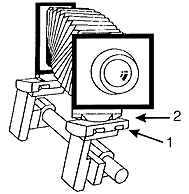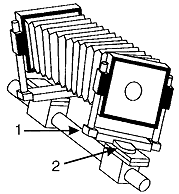| |
The content of this page is directly from B&H Photo
Large
Format, Part 1
Large
Format, Part 2
Introduction
To Large Format, Part III
Contents:
-
Image
Circle and Degree of Swing and Tilt
-
The
Scheimpflug Rule
-
Close-Ups
-
Yaw-Free
Image
Circle and Degree of Swing and Tilt
See
80k chart showing how Image Circle and Degree of Swing and Tilt works.
The circular
image which a lens projects on the focal plane is called the "image circle."
It is brightest in the center while (with a simple lens) both its quality
and brightness deteriorate towards the edges. The image circle determines
the lens usable field angle, one of the characteristics of every lens.
The field angle is the angle between a line from the center of the lens
to the outermost edge of the image circle, and a line to the center of
the circle. This is a unique, fixed lens characteristic that has no relationship
to focusing distance or image size. (It does, however, change with the
lens aperture.)
The lens minimum
image circle is measured at a particular focusing distance, usually at
infinity. When a nearby object is focused upon, the lens moves farther
from the film plane and, naturally, the image circle grows. In simple cameras
without swing or tilt, the image circle and the optical axis of the lens
always coincide. That means the diagonal of the film frame can, theoretically,
be as long as the diameter of the image circle. However, cameras are usually
designed with a somewhat smaller film frame to compensate for the loss
in brightness toward the edge of the image circle.
In a large format
camera with swing and tilt capability, the optical axis of the lens only
in rare cases intersects the film plane at its center. When a generous
amount of swing and/or tilt is applied, part of the film frame may wander
outside the image circle. This means that the maximum permissible swing/tilt
is limited by the size of the image circle.
Although the
size of the image circle can be enlarged by extending the bellows, using
excessive swing or tilt will result in part of the frame being outside
the image circle. To prevent this from happening, it is necessary to take
into account the lens type, image circle diameter and field angle before
setting the degree of swing or tilt. Even lenses of identical focal
length will have different field angles and image circles if their internal
composition differs; telephoto lenses, for example, have a narrower field
angle than their focal length would suggest.
The
Scheimpflug Rule
How
does the Scheimpflug Rule really work? Check out this illustration.
In order to use camera movements properly, an understanding of the Scheimpflug
rule is essential. This is the principle which enables us to form a focused
image of the subject even if it is at an angle relative to the camera at
wide open aperture.
If the subject
is at an angle relative to the optical axis of the lens, we can sometimes
bring the whole of it into focus by closing down the lens aperture and
thus increasing the depth of field. The problem cannot always be corrected
simply by stopping down, however (see picture on left). A host of related
problems can crop up as well, caused by such things as too slow a shutter
speed or stopping down the aperture too much (which will cause the picture
quality to deteriorate). Such difficulties are frequent when we rely only
on small f-stops to solve the problem.
If we use camera
movements based on the Scheimpflug rule however, we can bring the whole
of an angled subject into perfect focus without stopping down the aperture
at all. The Scheimpflug rule states that it is possible to keep in focus
all of the subject provided that the axis formed by its surface, the axis
of the camera front and the axis of the camera back all meet in a single
point. The Scheimpflug rule is a technique no photographer using camera
movements
can ignore.
Close-Ups
Large
format cameras permit macro or close-up photography without adding supplementary
bellows or extension tubes. Most view cameras can achieve anywhere from
a 1:1 magnification with a 210mm lens, up to 4:1 ratio with a 90mm lens.
Yet if additional magnification is needed, usually a supplementary bellows
can be added or a shorter focal length lens can be used.
Film exposure
with a view camera is the same as that of any other camera, except that
the bellows extension (the distance from the center of the lens to the
film) and reciprocity failure more often need consideration. As the bellows
extension increases, the intensity of the light reaching the film decreases.
The formula is as follows:
(bellows
length) x2 divided by (focal length) x2 = exposure
factor.
Assume that the
focal length is six inches (150mm), and the bellows extension is twelve
inches. Therefore:
12
(squared) divided by 6 (squared) = 144 divided by 36 =4x.
The exposure factor
is 4x (or two stops), so if the indicated exposure is 1/250 at f/8, use
a corrected exposure of 1/60 at f/8, or 1/125 at f/5.6 or 1/250 at f/4.
A simpler way to figure the needed correction is the 50 percent rule: For
every 50 percent increase of bellows extension over focal length, increase
exposure by one stop.
The table below
converts exposure factor into an exposure value for you.
| Exposure
Factor |
4X |
5.6X |
8X |
11X |
16X |
| Exposure
Value |
2EV |
2.5EV |
3EV |
3.5EV |
4EV |
Yaw-Free
Yaw
is defined as the sideways tilting of a standard when swing is applied
to the standard after it has been tilted. This results in standards which
are not parallel in any axis. A yaw-prone camera requires multiple adjustments
to maintain depth-of-field and focus when two or more adjustments are made
to the same standard. A yaw-free design allows the photographer to tilt
and swing a standard without having the second adjustment negate the benefits
of the first.

Whether a camera
yaws or not depends on the sequence of the joints. If the joint for tilting
about the horizontal axis (1) comes first in the standard block, the camera
design is yaw-free.

If however
the joint for swinging round the vertical axis (2) is located ahead of
the joint for tilting round the horizontal axis (1), the camera will be
suject to yaw.
Back
to Top |

